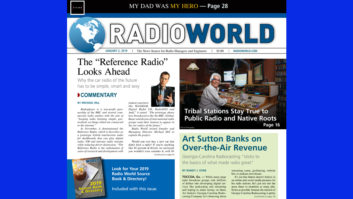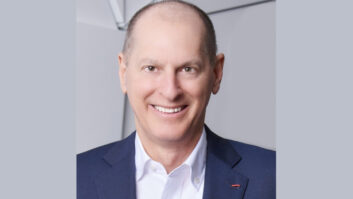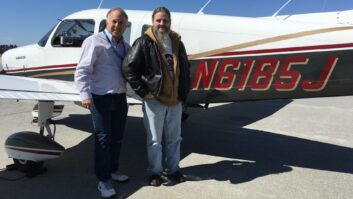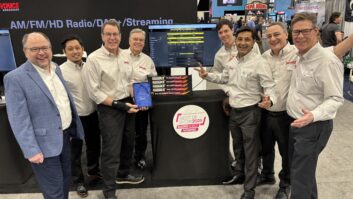Attentive transmitter shoppers will notice that a familiar face is missing from the Nautel booth at future shows. Gary Liebisch is retiring from his role as a regional sales manager (to be succeeded by another industry veteran, Ted Nahil).

Liebisch is known to many of us for his work on the manufacturing side — at Nautel and at Harris before that — but also earlier in his career as a chief engineer in Raleigh and Cincinnati.
I caught up with Gary recently.
Paul McLane: When you look back, what are you most proud of?
Gary Liebisch: I recently celebrated 50 years in broadcasting on Oct 29. As my hair began to gray, I took a lot of satisfaction on drawing from those years of experience to assist young engineers and non-technical managers in solving their RF transmission challenges. So the years with Harris and then Nautel afforded me that opportunity and was a lot of fun, particularly as HD Radio began to roll out. That technology was new to everyone 15 years ago, so everyone was hungry to learn, and I was in a position to share my knowledge.
McLane: Any mentors or early advocates you particularly are grateful for?
Liebisch: When I made the transition from on-air to engineering early in my career, I had a First Phone license but only my ham radio experience to draw from. I took on a number of AM directional antenna projects during the early years and am grateful to early mentors like Lawrence Behr, the late Palmer Greer, Ron Rackley and William Culpepper for their guidance. Mitch Montgomery was the Harris rep in the Carolinas in the ’80s, and when he came to town there was always an opportunity to learn. I said, “Gee, that’s the kind of job I’d like to do someday.”

Since there was no internet at the time, the SBE was invaluable as a resource. I think I may have been the first or one of the first certified engineers in the state of South Carolina in 1980, and I worked with Jerry Massey to start SBE Chapter 86 in Greenville-Spartanburg and later Chapter 93 in Raleigh.
McLane: At one point you succeeded Jeff Littlejohn as a chief engineer, which brought you to Ohio. What prompted you to switch to the vendor side?
Liebisch: The prospect of not carrying a pager? No brainer! Actually, within the first two months after I arrived in Cincinnati at Chancellor Media, I read in the local paper about the Harris plan to open a headquarters there. So I just sat tight as I watched those plans develop. Two years later it became a reality when that facility opened.
Initially I was a studio systems engineer — Harris was buying PR&E — but as HD Radio got closer to reality, I knew that RF transmission and this new technology was where I wanted to be. As an applications engineer and later, product manager, I was quickly immersed in the product development side and was put in the educator role for both customers and sales staff as HD Radio products rolled out.
I never did sales at Harris, but was a resource of technical information in support of the sales staff. So when I had the opportunity to become the first U.S.-based salesperson for Nautel, I knew I was ready. Wendell Lonergan told me in our first meeting that my background was exactly what they were looking for.
McLane: What’s the coolest product or project you’ve worked on?
Liebisch: When I joined Nautel in 2007, there were quite a few “holes” in the product line. Harris and BE were dominating the HD Radio rollout, so it was a risky move for me. But when I learned of the Nautel plan to introduce high-power solid-state FM (the NV series), I was excited. I felt this was a major breakthrough in FM transmitter development, and the industry really buzzed at NAB in 2008 when we introduced the NV40 for the first time.
For the next several years, we seemed to hit the ball out of the park each year with something new and innovating. It was great time to be in sales, as a lot of transmitters were being replaced. I would usually ask to see the customer’s transmitter site when I visited. This gave me the opportunity for a one-on-one with the engineer for an hour or two where we could talk about the many aspects of the project.
McLane: Would you encourage a young person today to pursue a career in broadcast engineering technology?
Liebisch: Forty years ago when you thought “high-tech,” you thought broadcasting. And it was not unusual to see a ratio of engineers per station greater than one. Now “high-tech” encompasses so many other diversified fields. A young person has a wide array of choices, which is why there is such a shortage in broadcasting of young engineers. While opportunities exist for experienced engineers to take on a full facility, the opportunities for mentoring are more limited, but they do exist. Ratios are reversed.
You really need to live and breathe the “culture” of broadcasting as a prequalification, or you’ll inevitably be lured away to another field.

McLane: What are your plans? And any other thoughts?
Liebisch: I hope to remain active in the industry, and perhaps entertain special projects from time to time. I have taken on a local non-com station just to keep my hands dirty on a Nautel transmitter. My man cave in the basement of our home houses my O gauge model railroad layout, my ham radio shack (W8GEL) and my radio airchecks collection. My wife and I also enjoy traveling to U.S. national parks, and there are still many more to see.
I would just want to acknowledge the great engineering teams I worked with at both Harris and Nautel. I worked with Geoff Mendenhall and the Harris team on the groundbreaking Flexstar project. And with Nautel, the team led by Mike Woods was equally aggressive and innovative in making high-power solid-state HD FM a reality.
Read an interview with Nautel’s Ellis Terry about his own retirement at https://tinyurl.com/rw-terry.







